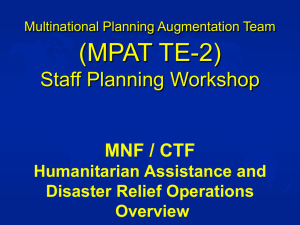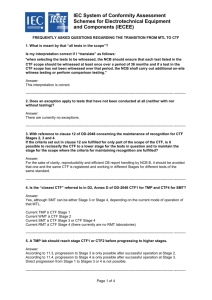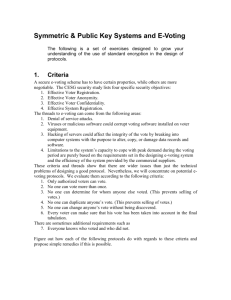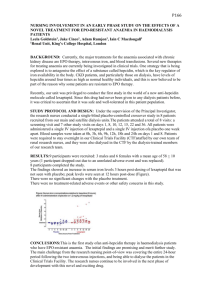opt diagram
advertisement
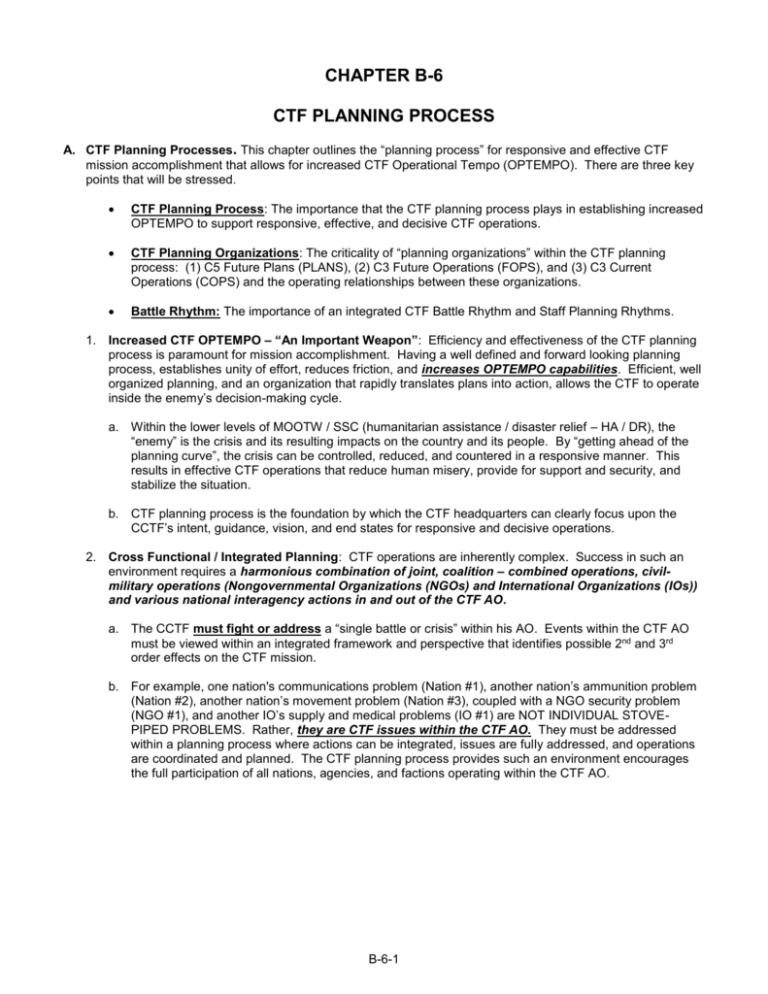
CHAPTER B-6 CTF PLANNING PROCESS A. CTF Planning Processes. This chapter outlines the “planning process” for responsive and effective CTF mission accomplishment that allows for increased CTF Operational Tempo (OPTEMPO). There are three key points that will be stressed. CTF Planning Process: The importance that the CTF planning process plays in establishing increased OPTEMPO to support responsive, effective, and decisive CTF operations. CTF Planning Organizations: The criticality of “planning organizations” within the CTF planning process: (1) C5 Future Plans (PLANS), (2) C3 Future Operations (FOPS), and (3) C3 Current Operations (COPS) and the operating relationships between these organizations. Battle Rhythm: The importance of an integrated CTF Battle Rhythm and Staff Planning Rhythms. 1. Increased CTF OPTEMPO – “An Important Weapon”: Efficiency and effectiveness of the CTF planning process is paramount for mission accomplishment. Having a well defined and forward looking planning process, establishes unity of effort, reduces friction, and increases OPTEMPO capabilities. Efficient, well organized planning, and an organization that rapidly translates plans into action, allows the CTF to operate inside the enemy’s decision-making cycle. a. Within the lower levels of MOOTW / SSC (humanitarian assistance / disaster relief – HA / DR), the “enemy” is the crisis and its resulting impacts on the country and its people. By “getting ahead of the planning curve”, the crisis can be controlled, reduced, and countered in a responsive manner. This results in effective CTF operations that reduce human misery, provide for support and security, and stabilize the situation. b. CTF planning process is the foundation by which the CTF headquarters can clearly focus upon the CCTF’s intent, guidance, vision, and end states for responsive and decisive operations. 2. Cross Functional / Integrated Planning: CTF operations are inherently complex. Success in such an environment requires a harmonious combination of joint, coalition – combined operations, civilmilitary operations (Nongovernmental Organizations (NGOs) and International Organizations (IOs)) and various national interagency actions in and out of the CTF AO. a. The CCTF must fight or address a “single battle or crisis” within his AO. Events within the CTF AO must be viewed within an integrated framework and perspective that identifies possible 2nd and 3rd order effects on the CTF mission. b. For example, one nation's communications problem (Nation #1), another nation’s ammunition problem (Nation #2), another nation’s movement problem (Nation #3), coupled with a NGO security problem (NGO #1), and another IO’s supply and medical problems (IO #1) are NOT INDIVIDUAL STOVEPIPED PROBLEMS. Rather, they are CTF issues within the CTF AO. They must be addressed within a planning process where actions can be integrated, issues are fully addressed, and operations are coordinated and planned. The CTF planning process provides such an environment encourages the full participation of all nations, agencies, and factions operating within the CTF AO. B-6-1 ===================================================================================== B. CTF Planning Process. The CTF planning process centers around one simple principle: The CTF planning structure must provide for an “integrated and managed process” for the movement of plans from the planning stage, to the refinement stage, and then to the execution stage. This SOP establishes a three-fold planning focus that allows for a current operational focus while ensuring the CTF command is continually preparing for future operations and potential contingencies at all times. Outlined below are these three focuses. #1: Mid-Term to Long Range Planning Cell: One cell must focus on the “mid –term to the long range” verses the near term and present operations. This allows for operational flexibility and agility in planning. Also, contingency and special planning can be conducted to be prepared for opportunities and potential threats. Planning range for this cell are normally beyond 96 hrs from current operations time frames. #2: Near-Term Refinement / Updating Cell: One cell must focus on the “near term” and take the midterm plans and long range plans and “refine / finalize” them by integrating in the operational realities of the CTF situation. This cell integrates the near term situational awareness and commanders guidance to arrive at an OPLAN that is ready for execution. Planning range for this cell is normally 96 hrs to 24 hrs. #3: Current Focus, Monitoring, and Adjustments Cell: One cell must focus on current operations and situational awareness making final “fine tuning adjustments” to OPLANS just prior to issuance. This cell also issues the order and monitors its execution making near time adjustments in accordance with commanders directives and component commanders’ requirements. Note: The timeframes outlined above are only an initial guide for establishment of the planning focus for each cell. It is possible that CTF operations (especially larger scale operations) may require different timeframes such as MId-Term Cell - 5 to 7 days and beyond, Near-Term cell less than 5 days to 48 hrs, and Current Operations cell 48hrs and less. The CCTF commander and staff will develop the cells planning focus based upon mission requirements. Outlined below is the three-fold planning focus that serves as the foundation for the CTF planning process. The above diagram intentionally does not use the planning cells names since many diverse terminologies are used for these functions by nations. This SOP’s naming convention will be addressed in following sections. The key factor to recognize is that the CTF planning process must be organized in a manner to clearly support the simultaneous operation of the above functions. Within multinational operations, the requirement for well developed plans that are thoroughly coordinated and continually refined cannot be overemphasized due to the complexity and the nature of multinational operations (see Chapter A-1). B-6-2 C. CTF Planning Cell Terminology and Functions. This SOP uses the naming convention of C5 Future Plans (PLANS), C3 Future Operations (FOPS), and C3 Current Operations (COPS) to name the respective functions for the three planning functions. Throughout this SOP the CTF planning process will be normally be referred to simply as PLANS, FOPS, and COPS for brevity. However, the longer terminology (such as C5 Future Plans, etc.) may be also used in some chapters at times for clarity. Outlined below are the responsibilities for each of these cells. 1. C5 Future Plans (PLANS): C5 Future Plans focuses on initial development of crisis response plans, campaign planning, follow-on operational phase planning, and sequel plans. Figure B6-2 below summaries the responsibilities outlined below. a. Develops initial operational plans / operation orders (OPLANS / OPORDS), campaign plan, and sequel plans as required. b. Conducts planning, analysis, and coordination of future plans (generally 96 hours and beyond) during the execution phase. The focus is on the next operational phase and operational sequels. c. Develops Courses of Actions (COAs) within the framework of the CCTF intent, vision, and guidance, assigned mission, forces available; and higher commander’s intent (and Lead Nation NCA guidance). Wargaming of COAs is conducted if assets and time are available. d. Coordinates planning efforts within the CTF with the coordination centers (CCC, CMOC, and CLCC). e. Prepares future operation plans, briefings, reports, and other required products. Maintains close coordination with the C3 COPS for refined awareness of enemy and friendly situation. Conducts close coordination with C3 FOPS during development of COAs, operational plans (OPLANS), or operational orders (OPORDS). f. Conducts CCTF decision briefs, updates, and wargaming briefs as required. g. Conducts formal plans “hand-off” coordination and briefing sessions with C3 FOPS. B-6-3 2. C3 FOPS: The C3 FOPS is responsible for future operations' planning that occurs within the 24 - 96 hour timeframe. During activation, C3 FOPS is focused on CTF activation, the initial CTF response, and deployment of initial response forces. FOPS represents the C3 in the planning process to ensure continuity between C5 Future Plans and C3 COPS. C3 FOPS establishes an OPT tailored to the situation. Liaison from coordination centers (CCC, CMOC, and CLCC) should be included in the FOPS to fully integrate coalition, civil-military aspects, and logistics coordination required within the CTF AO. Figure B63 on the following page summaries the responsibilities outlined below. a. Receives the hand-off of OPLANs and OPORDs from C5 Future Plans, and, in turn, drafts final draft orders C3 COPS who finalizes order preparation and issuance. b. Reviews, refines, adjusts, updates, coordinates, and drafts OPLANs and OPORDs into final form based upon: (1) The C3 FOPS assessment of the current operation (friendly and enemy situations and threat) provided by the C3 COPS to the FOPS OPT. (2) A FOPS projection of future status of friendly forces for the next 3 days and projections of enemy threat actions as advised by the C2. c. Conducts parallel planning coordination with CTF components and coordination centers (CCC, CMOC, and CLCC). d. Conducts CCTF decision briefs, updates, and wargaming briefs as required. e. Develops projections of friendly forces status for the next 96 hours. f. Coordinates targeting and collection aspect of FOPS plans with the Coalition Targeting Coordination Board (CTCB). g. Synchronizes future maneuver with fires and collections with COPS. h. Maintains situational awareness to identify emerging requirements for branch plans and transitions to follow-on phases (a FOPS representative is a member of the C5 Future Plans OPT). i. Provides representation as necessary to CTF boards and cells. The following list is a “starting point” for consideration: (1) Combat Assessment Cell (2) Logistics Cell (3) Coalition / Combined Planning Group (4) Force Deployment / TPFDD Working Group (5) C4I Cell (6) Coalition Targeting Coordination Board (7) Coalition / Combined Collection Management Board (8) Coalition / Combined Assessment Team (9) Information Operations Cell (10) Rules of Engagement Cell (11) Public Information Cell (12) Search and Rescue Cell (13) Coalition / Combined Information Management Board j. Manages RFIs within Future Ops. k. Ensures smooth transition of plans from C5 Future Plans to COPS for execution. A “C3 FOPS Continuity Project Officer” needs to be established for each plan or order. This planner will join the designated “C5 Future Plans Project Officer” as the plan is “handed-off” to C3 FOPS. These planners stay with the plan / order to its end state (C3 COPS hand-off to COC Battle Captain and Watch). B-6-4 ===================================================================================== 3. C3 COPS: The C3 COPS monitors execution of plans and maintains current situational awareness (SA) within the CTF. The scope of this work is normally defined as operations from the present to plus 24 hours. This SA is focused on disposition of all CTF friendly and supporting forces, to include: coalition / combined military forces, civil-military agencies (IOs and NGOs) and their operations, host nations military and civilian forces, civilian populations, and refugee personnel. Figure B6-4 on the following page summaries the C3 COPS responsibilities and integrates them into CTF planning process along with the C5 Future Plans a. Receives hand-off of OPLANs and OPORDs from the C3 FOPS and prepares and finalize the execution order. b. Presents a plans “hand-off” briefing to the Coalition / Combined Operation Center (COC) and the Battle Captain (COC Watch OIC), Battle Watch Staff, and Battle Watch Functional Staff / Liaison. c. Coordinates a CTF component “back brief” on respective OPORDs and FRAGOs within 24hrs after issuance. CTF component LNO teams or other designated component representatives can conduct this back brief as the situation dictates. d. Maintains current situational awareness (present to + 24 hrs). e. Prepares pertinent message traffic in support of current operations. f. Prepares daily Situational Reports (SITREPS). g. Prepares daily morning and evening situations briefs. h. Disseminates refined and assessed operations information throughout CTF staff and coordination centers IAW releaseability criteria for classified information. i. Works closely with the CTF Battle Captain (COC Watch Officer / OIC of COC) to track real time message traffic and reporting monitoring. j. Monitors plan execution and adjusts plans based upon CCTF directives in the form or FRAGO, messages, and directive. B-6-5 D. Planning Concept Overview: The above diagram outlines the CTF planning process and shows the plans hand off process between the CTF planning cells (PLAN, FOPS, and COPS). The CTF command group (CCTF, DCCTF, and COS) prioritizes the planning efforts and provides direction and guidance as required. The CTF battlestaff provides their respective staff functional input to the planning process to support plans development and provides subject matter expertise to the planning cells as required. The CTF lead for planning is normally the C5, especially during initial OPLAN development. Once CTF plans moves to execution of the OPORD, the C3 may become the lead for the plans process; however the above planning process remains unchanged. The lead position can vary depending on the nature of the crisis and phase of plan development/plan execution. The essential factor for this structure is an “integrated, and managed process” for movement of plans from the “planning stage to the execution stage” while maintaining operational planning flexibility / agility by focusing on the current operational situation and continually preparing for future plans/operations and potential contingencies. ======================================================================================= B-6-6 (page intentional blank) B-6-7 E. Coalition / Combined Planning Group (CPG) and Operational Planning Team (OPT) Concept. 1. CPG / OPT: To assist the planning process the concept of Coalition / Combined Planning Group (CPG) and Operational Planning Team (OPT) are used by the C5 Future Plans and C3 Future Operations respectively. It should be noted that these terms are used interchangeably by nations and within doctrines; however, for clarity this SOP will use the convention outlined below. 2. C5 Future Plans uses the CPG as its central planning group. The CPG is considered as the primary planning element for the CTF. Normally, this group consists of a small group of full-time planners focused upon future planning actions. This CPG is readily "expandable" to larger planning groups as the situation or planning task requires. An expanded CPG normally will include a broad cross-functional representation consisting of appropriate representation from staff, CTF components, LNOs, functional elements, C5 Future Plans, C3 Future Operation and C3 Current Operations. 3. C3 Future Operations uses the OPT concept as its central planning group. The FOPS OPT is similar to the CPG except that its focus is on the near-term and refinement of prepared OPLANS (or OPORDS) as required by current situational realities and CCTF guidance. The core FOPS OPT consists of a small group of full-time planners focused on refinement and branch planning to meet the rapid changing situational factors. The FOPS OPT is readily "expandable" to larger planning groups as the situation or planning task requires. The FOPS OPT works closely with C3 Current Operations to maintain situational awareness and works closely with intelligence channels to clearly identify emerging crises / adversary situations. Note: OPTs are also used by other staffs within the CTF command to focus on “specific and special” planning actions. Examples include special plans OPTs, deployment planning OPTs, logistics planning OPTs, transition planning OPT. However, there is only one FOPS OPT within the command and the only OPT within the CTF planning process at the PLANS, FOPS, and COPS level of planning . 4. CPG / OPT Organization. Figures B6-5 and B6-7 on the following page provide “possible start points” options for organizing the CPG. These planning groups are readily "expandable" to larger planning groups as the situation or planning task requires. The CTF command group and staff will determine what concept and organization best supports the mission. FOPS can use similar concepts for organization of their OPT; however, the FOPS OPT will normally be smaller in size and have tailored membership to address specific OPLAN refinement or branch planning. ===================================================================================== B-6-8 F. Coordination Center Liaison is Critical: Liaison from respective coordination centers is critical for unity of effort. The Coalition Coordination Center (CCC), Coalition Logistics Coordination Center (CLCC), the CivilMilitary Operation Center (CMOC), and the Coalition / Combined Media Coordination Center need to have liaison with the PLANS, FOPS and COPS for effective coordination of coalition forces, civil-military operations, multinational logistics functions, and media relations. B-6-9 G. Battlestaff Plans Hand-Off / Backbriefs: To prepare for execution of an operational plan, “battlestaff plans hand-off” briefing sessions should be conducted. A backbrief is a formal briefing on all aspects of the OPORD or OPLAN. This serves as a "hand off" of responsibilities to the next planning cell within the CTF plans structure. The Component backbrief to the C3 COPS, or other designated CTF cell, is a formal brief on the OPORD or OPLAN to confirm that the components understand all aspects of the orders. The LNO team can handle this backbrief. Special backbriefs by component staff or commanders maybe required in certain circumstances. 1. Backbrief / Hand-Off Recommendations: Listed below are recommended backbrief / hand-off sessions. a. C5 PLANS to C3 FOPS. b. C3 FOPS to C3 COPS. c. C3 COPS to COC Battle Captain and Watch Staff. d. CTF Component Backbrief to C3 COPs NLT 24 hrs after order issuance. 2. A “battlestaff hand-off” briefing may utilize some of the following components: a. Briefing and Coordination session. b. Operational plans / order sketches and overlays (digital and paper). c. OPORD / OPLAN executive summary with briefing slides. d. Planning and Execution Aids (as determined by the C3 and C5): (1) Execution Matrixes (2) Decision Support Matrixes (3) Synchronization Matrixes (4) Time Line Synchronization Matrixes (5) COA Analysis Sheets (for reference) e. Branch Plans COA / sketches and overlays (digital and paper). f. Working Sequel Plans as applicable (overviews vice details). B-6-10 H. CTF Branch and Sequel Planning: Branch and sequel planning provides operational flexibility and agility. It allows rapid responses that are thought out, coordinated, planned, resourced, and communicated throughout the CTF. 1. Sequel Operations: Sequels normally focus on "new planning" for major changes to follow-on phases or possible contingencies for which no plans are presently developed. Sequel planning can expand the details of follow-on phases, create new or additional phases, or entirely change the OPLAN or campaign plan. For example, in terms of Fig. B6-7 below, the CTF is executing Phase 1 and the CCTF determines that contingency planning for withdrawal operations and NEO plans may have to follow Phase 1 Operations. Presently, there are no plans for these contingencies. Sequel planning creates these new contingency plans for possible execution after phase 1 end states are achieved. The overall intent of the current plan could stay the same, be refined or modified for sequel plans. PLANS normally plans, coordinates, and prepares sequels for current OPORDS, OPLANS, and/or campaing plans. 2. Branch Plans: Branch plans address emerging requirements within the current phase of the plan being executed. However, the overall intent of the plan stays the same. For example, in terms of Fig. B6-7 below, the CTF is executing Phase 1 and an unforseen crisis/threat emerges. A "branch" to the current Phase 1 OPORD is developed to address the new crisis/threat. This is normally accomplished through the use of a FRAGO or message to address the new crisis / threat. Multiple branches can be developed to ensure preparedness for various potential short-term contingencies. FOPS normally plans, coordinates, and prepares branches for the current phase of an OPORD Figure B6B6-7: BRANCHES AND SEQUELS Current Situation Br To anch Pla n Sequ el Chan ge to Basic Plan Basic Plan Ph I Endstates Remain the Same New Contingency Plans Required Phase 2 Endstates May Require Possible Revision ===================================================================================== B-6-11 I. Operational Planning Flexibility - Planning Options. The CTF planning process of PLANS, FOPS, and COPS is a “start point” and is NOT RIGID in execution. “Roles and missions” can be adapted to meet workloads, situational demands, operational needs, and CCTF requirements. The CTF planning process is inherently flexible and can be adjusted by the CCTF and staff as required by mission and workload requirements. Some of the primary options available are outlined below: Option #1 – PLANS / FOPS / COPS: Plans development can start in PLANS, transition to FOPS for preparation for execution, and then transitioned to COPS for execution (normal sequence). Option #2 FOPS / COPS: Plans can be fully developed in FOPS and then transitioned to COPS for execution. Option #3 COPS ONLY: A short notice branch plan could be solely developed and executed in COPS. B-6-12 J. CTF Battle Rhythm: The last factor in an efficient and effective planning process is having an integrated and coordinated “CTF Battle Rhythm”. A Battle Rhythm is a graphic representation of the routine schedule at a headquarters or command post. The complexity of the decision-making process requires a systematic schedule that focuses the staff effort to provide the commander with the right information in the right format at the right time. A published Battle Rhythm facilitates flow of information in the chain of command because all subordinate elements can predict when information is required. Effective CTF operations require one synchronized, strategic, operational, and tactical Battle Rhythm. It can be shown in a number of styles: 1. The first example below illustrates CTF Battle Rhythm adjusted to synchronize with the Supported Strategic Commander’s requirements to feed information to the National Command Authority (NCA) where the US is the Lead Nation and USCINCPAC is the supported strategic commander. The times reflect where a CTF is in Southeast Asia. Note how once a Battle Rhythm is decided on, it can be adjusted like twisting the bezel ring on a compass. This allows the CTF to execute operations with flexibility while meeting higher headquarters’ need for information (Note this is a simplified diagram – not all events have been shown). Figure B6-8: CTF Battle Rhythm 2. The second Battle Rhythm example illustrates how a subordinate component (in this case, 3rd MEB as the core staff of the CFLCC HQs) would synchronize with its CTF headquarters, and, subordinate submission requirements. Even at the component level, an awareness of the flow of information all the way to the supported strategic commander is present (USCINCPAC in this example). Instead of a rotating bezel ring, this Battle Rhythm is linear and can be slipped left and right to adjust to the higher headquarters. B-6-13 The Chief of Staff (CofS) publishes a daily operations cycle to adjust the CTF Battle Rhythm to day-to-day requirements, availability of the commander, VIP visits, and briefing requirements that arise. Examples of reasons the basic Battle Rhythm would need to be modified include a major confirmation brief on an upcoming phase of the operation, a commanders’ meeting taking the place of a normal daily brief, etc. Likewise, if FOPS or Plans were developing a product that would take several days to prepare, their daily brief would probably be deleted from the daily schedule. Obviously, if the CCTF is going to be unavailable during the time that he would normally get a decision brief, that brief would have to be rescheduled, as would the rest of the processes that either feeds or follows the subject brief on the Battle Rhythm. Figure B6-8 3. CTF Staff “Planning” Rhythm Concept: Within the CTF, each staff section, board, cell, or committee creates and publishes its own schedule to receive information, analyze it, and have a product available at the time required by the CTF’s Battle Rhythm. This is called the Planning Rhythm. A Planning Rhythm nests into, and supports the CTF Commander per his Battle Rhythm. Like the CTF Battle Rhythm, a CTF staff Planning Rhythm is a powerful friction-reducing tool enabling subordinate staffs to anticipate and prepare ahead of time instead of reacting to requests for information from higher headquarters. When properly designed, the CCTF can decide and act faster than his adversary by increasing ability to plan various elements of a joint operation in a parallel and collaborative manner, rather than in a sequential and hierarchical manner. B-6-14
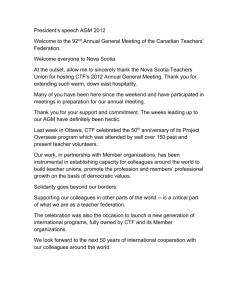
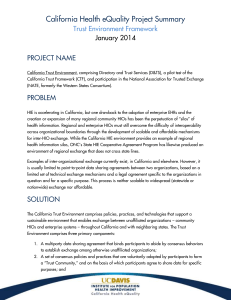

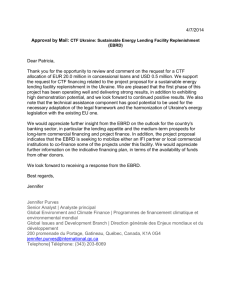
![Cherish the Family [PPT] - National Abandoned Infants Assistance](http://s2.studylib.net/store/data/005476619_1-44768cf7ece3219205cc51da81672e3a-300x300.png)
